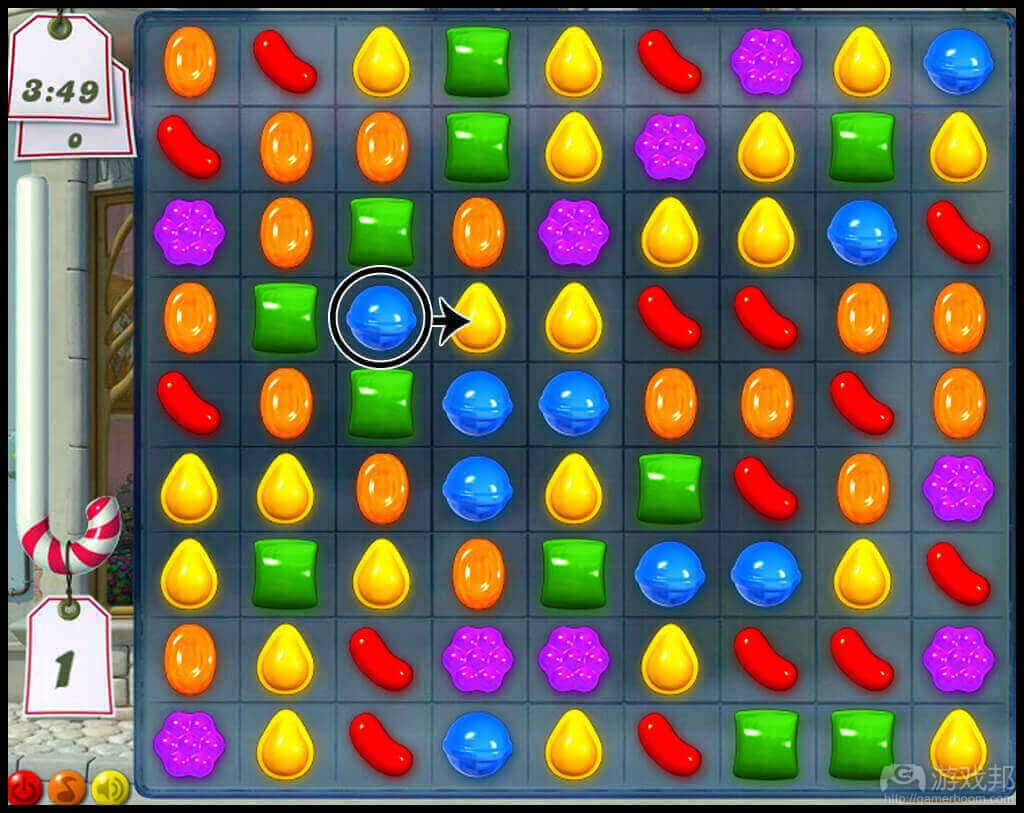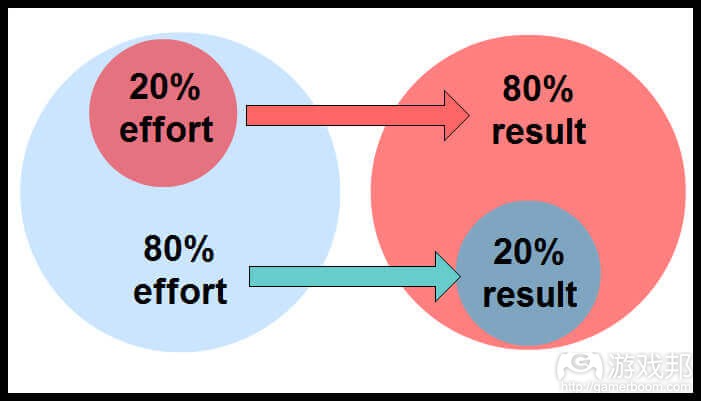开发者分享如何在游戏设计中做到难易程度的平衡
本文原作者:Tejas Jasani 译者ciel chen
第一步 游戏需要平衡
美国每年要上映很多部电影,有各种你能想到的电影类型:喜剧电影、惊悚电影、动作电影、爱情电影等,然而并不是所有的电影都能大卖,也并不是所有的电影都能风靡全球。不过这样的电影也是有的,维基百科称《侏罗纪公园》在国内(美国)首映的第一个周末总收入2.088亿美元,那个周末成为美国史上票房高的周末。
现在人们已经不是第一次在荧幕上看到恐龙了(这部电影本身就已经是《侏罗纪公园》系列电影的第四部),现在的恐龙到处都能看到。然而这么多同类电影都有着美好的画面、精彩的动作内容、美丽的摄影,为什么唯独《侏罗纪公园》系列电影能脱颖而出获得这样疯狂的成功呢?
如果能用一个词来说明的话,那就是:平衡。
该系列作在某种程度上把握好了(或者基本把握住了)作为优秀电影在各个方面的平衡艺术——它平衡了电影中机智与严肃的对话、平衡了合适的恐怖效果(恐怖和平常情景在电影中交替呈现)、平衡了电影中在冲突达到高潮时音乐的添加与在强调某个场景的重要程度时突然陷入的沉默之间的平衡。总而言之,《侏罗纪公园》系列电影把所有能平衡的都给平衡了。
相同的概念也可以延伸到游戏界,而这也是我今天想和你们分享的内容。
让我们用两款成功的游戏巨作来做个比较:《使命召唤》和《糖果粉碎》。
如果你忽略游戏输赢或者得分的话,你也会同意《糖果粉碎》从基本层面上来说一款很容易就能上手的游戏。比如说,假如你在过123关的时候,游戏玩法的难度并没有变化,只是想得高分变得没那么容易了而已。
而另一方面,从基本层面来说《使命召唤》(“杀死敌人”)也应该是挺容易的,就是玩游戏的时候得要弄明白一些有关如何操作武器、目标瞄准、以及使用合适的资源等等。这不表示游戏会变的很复杂到没办法让人享乐;这只是说明它属于困难类型的那类游戏而已。
然而两款游戏都获得了相当相当大的成功。
因为两款游戏强调的原则内容都是非常相似的。
是的,《糖果粉碎》强调的原则就是让简单程度保持在合适的范围、《使命召唤》则将复杂程度保持在合适的范围。
Jesse Schell在他的著作《游戏设计的艺术》中这样说道:游戏需要“刚好的简易度”与“刚好的复杂度”。
第二步 了解复杂性的种类
Jesse Schell在他的著作《游戏设计的艺术》中将复杂性分为两个种类。
2.1 固有复杂性
固有(内部)复杂性就是游戏本身玩起来就困难并且还有设立了一堆的规则。如果游戏有太多规则要遵守,那很容易在游戏早期就让玩家有一种“嘿!你之前没说过要这样!”的内心活动。
这是因为玩家不能也不想去记住那么多的规则,这将潜移默化地打击玩家积极性让游戏落得个坏名声的。
所以一般什么时候会出现这种游戏的固有复杂性?
当设计者试图把真实生活的情景也忠实地照搬到游戏里的时候,那游戏就会有非常非常多方面的问题要考虑要顾及了。
像在《地铁跑酷》这类的游戏里,如果设计者要认真到考虑起物理概念中的摩擦力、离心力和向心力,还有鞋子鞋面的磨损之类的问题的话,那这个游戏要玩起来就真的太困难了(除非、对物理学家来说可能他们玩得来!)。
设计者因此需要控制自己游戏中有关现实内容的考虑。这里有个不错的比喻可以记一下:完美的地图是不存在的。
一幅地图,要想让它完美而精确,连一颗石子都不放过的程度,这需要它有跟目标位置一样规模的大小。这样的话,曼哈顿地图就要跟曼哈顿一样大,不仅不可能做出来,要想带着这样的地图绝对超累。
2.2 新生的复杂性
Schell提到的第二种复杂性就是新生复杂性。这种难度是不会在玩家一开始玩游戏的时候体现出来的,但是它会随着玩家玩的过程中慢慢浮现出来。
这样的困难程度比什么都要更容易让玩家面对更令人兴奋的挑战。
《皇室战争》一直在更新添加新卡片,带来各种各样的能力特效来让玩家依旧愿意浸入到游戏中去。
你在玩《Color Switch》的时候,从第一关到其他关都会有很多各种不同的彩色组合出现。
也就是说有可能(也确实如此)一款游戏——就应该做得容易上手但是难以精通。成功的游戏会让玩家能很容易就入门,这样玩家就可以从金字塔的底部开始慢慢往上爬。
随着玩家慢慢尝过几次胜利的喜悦以后,游戏会开始增加难度,让每次的挑战变得稍稍更有乐趣些。
因此保持游戏的固有复杂程度在较低水平,并在新生复杂性上能有一个较大的调节范围是最好不过的了。
这样以来玩家就能以一种投入的方式体验游戏难度等级的上升——这让我想起我的一个朋友Parry已经打到《糖果粉碎》的第450关,并且到现在还没放弃呢。
无论如何,倘若把固有复杂度抛之不顾依旧是不合理的。那些基于真实生活的模拟游戏,或者甚至是科幻类游戏,都别无选择,一定得保持一定程度的固有复杂性。
要知道如果一场星系间的大战只有0.45英寸柯尔特自动手枪弹可以拿来火拼的话会看上去很傻的。
80/20巴雷特法则
有一些设计者倡议要按照80/20巴雷特法则来平衡新生和固有复杂性的平衡。也就是让固有复杂性保持在某个最低程度然后让新生复杂性持续提升!
这里我们就有一个重点问题了:要如何才能让你的游戏保持难易度上的平衡呢?
第三步 平衡游戏难易程度的三个维度
为了平衡你游戏的难易程度,就虑从三个维度上考虑这个问题。
3.1 让复杂程度有组织有规划地增加
游戏设计中经常出现随着游戏的进展,规则变得越来越多越来越复杂——然而这未必是个好主意。
就假如说你在设计一款游戏,这款游戏需要玩家比赛穿过神秘的海洋水域,同时还要打败各种各样的鲨鱼、鲸鱼和海怪。
在游戏的一开始(比如说第一关),只给了玩家唯一一只特殊的船,它可以在海上航行也可以在海底航行(像潜水艇一样)。玩家可以兴奋地用它一直到第四关。
突然,游戏告诉你这只船将不再可以潜水了。
这既让人沮丧又让人觉得不公。我指,为什么玩家取得胜利到达了第四关现在却要接受惩罚?这种突然在规则上的改变时不公平的。
这就跟我们所说的“有组织有规划地成长”形成了鲜明的对比。如果规定了一艘船可以在水底潜行,那这只船无论怎样就是应该可以潜行在水底。
从另一方面来说,随着玩家从第一关到之后的关卡,这里有个让游戏有组织有规划地增加难度的简短方法清单:
新型怪的出现
有一些怪兽需要被击退两次才会死
可以设置一个漩涡,可以把你的船吸进去
突然出现的泥水,会消耗你更多的燃料
天气的变化来降低可见度
鲸鱼把你的氧气瓶咬漏了,让你难以再在海底潜行
自由浮动的冰山会摧毁你的船,或者可能影响它的操作性。
正如你所看见的,复杂度的增加是可以通过更多的挑战,更多的刺激、更多的惊喜来实现,而不需要任何基础前提的改变。
3.2 改变键盘按键控制,这要求更高的玩家键盘技术
你也许不能改变规则,但你绝对可以改变控制方法:)
上图是流行游戏《公路骑手》的一副截屏。
控制方法很简单:
右边是加速(油门:用来控制速度),左手边的是刹车。很简单。
随着关卡越高级,就说第9关把,游戏让你在控制上有了一些扭转。
控制键的变化:
现在加速控制移到你的左手边了,而刹车则换到了右手边。(当然了,游戏完全没有提示你控制键的转变!)
了左刹车右油门的机制的玩家就会突然愣住不知所措。玩家需要一些时间来习惯这种控制上的转变;谁知道呢,玩家说不定就撞了也不一定呢!
点可以确定的是:随着控制键的改变,玩家会投注更多的注意力到游戏中。随时有可能撞车的害怕让玩家肾上腺激素剧增(一种让人类身体产生激动感的身体激素)。这让玩家对游戏非常兴奋非常投入。
要注意,这里你没有做出任何根本性的改变:你只是转换了控制键而已。没有剥夺玩家的能力和技能,而且玩家还能从中达到令人兴奋的新水平。
3.3 提出有意义的问题
决定复杂程度的等级是一个人得回到问题里最难的那个问题。所以你设计你下款游戏时候,或者回顾你已经设计好的游戏的时候,
你也许会想要问你自己这三个问题:
我的游戏是否太简单或者太复杂吗?
我设计游戏的复杂程度是让玩家感到兴奋还是让他们不再想玩呢?
我还可以在游戏中加入哪些新生的内容来让玩家更能投入到我的游戏当中呢?
本文由游戏邦编译,转载请注明来源,或咨询微信zhengjintiao
Step 1 The need to balance a game
Dozens of movies get released every year in the US. They belong to every genre that you can think of: Comedy, Thrillers, Action, Romance, But not all movies make truckloads of money.
Not all movies are loved the world over. For instance, Wiki says Jurassic World grossed $208.8 million domestically in its opening weekend, making it the biggest domestic opening weekend of all time.
Now it’s not that people saw dinosaurs on screen for the first time (this movie itself is the fourth instalment of the Jurassic Park franchise). There are umpteen other clones too.
Many movies in the same genre have lovely graphics, great action, beautiful photography and so on. So what makes the Jurassic Park franchise stand out and remain insanely successful?
If it could be put in one single word, the word would be: balance.
The franchise has somehow mastered (or come close to mastering) the art of balancing various aspects of a great film. It balances wit and grave dialogues, it balances the right scare-effects (scary and normal situations keep alternating throughout the movie), balances between musical score increasing in pitch during conflicts and then suddenly going silent to super-emphasize the impact of the situation.
In short, the movie does almost everything in balance.
The same idea can be extended to the gaming world. And that’s what I’d like to share with you today.
Let’s start by comparing two hugely successful games: Call of Duty and Candy Crush.
If you ignore the aspect of winning or scoring, you will agree that at a fundamental level, Candy Crush is a lot easier to start and understand. Even when you cross a level, say level #123, the difficulty of gameplay itself does not change; it’s just that scoring won’t be as easy.
On the other hand, while the basic premise of Call of Duty (“kill enemies”) may be simple enough, playing the game takes a lot more understanding in terms of handling weapons, choosing targets, using the right resources and so on. That’s not to say it’s too complicated to be enjoyed; it’s just that it belongs to a different category.
Yet both games are very, very successful.
Candy Crush and Call of Duty
That’s because the underlying principle in both the games is very much the same.
So, the common underlying principle is that Candy Crush uses the right amount of simplicity, while Call of Duty uses the right amount of complexity.
Jesse Schell, in his celebrated book The Art of Game Design, says games need to use “Good Simplicity” and “Good Complexity”.
Step 2 Classification of complexity
In his celebrated book The Art of Game Design Jesse Schell, classifies complexity in 2 part.
2.1 Innate Complexity
Innate (as in inner) Complexity is when the game itself is difficult to play and the rules are many. If you keep too many rules , then early in the game the gamer will reach a point when she gets a feeling “Hey! You didn’t mention this before!”
That’s because, the gamer can’t / doesn’t want to remember too many rules.This can be potentially frustrating and get the game a bad name.
So when is this Innate Complexity mostly likely to happen?
When the designer tries to replicate a real-life situation too faithfully, the game will need to take care of too many variables.
In games like Subway Surfer, for instance, if the designer starts taking ideas of physics like friction, centrifugal and centripetal forces, wearing away of surfaces etc. too seriously, it’d be too difficult a game to play (except, perhaps, for the physicists!).
The designer, therefore, needs to restrict the extent to which the game uses the elements of reality. There’s a nice analogy to remember: A perfect map can never exist.
For a map to be perfect and accurate, down the last pebble, it needs to be of the exact size of the location. That way, the map of Manhattan needs to be of the size of Manhattan itself, which is both impossible to make and certainly not easy to carry!
2.2 Emergent Complexity
The second type of difficulty Schell mentions is Emergent complexity. This kind of difficulty is not present when the gamer begins playing your game, but it emerges along the way.
This sort of difficulty has more to do with posing better and more exciting challenges to the gamer than anything else.
Clash Royale keeps coming up with various cards that carry a variety of capacity and keep the gamer engaged.
Clash Royale Cards
Color Switch keeps coming up with a variety of color combos as you go from one level to the other.
Color switch Gameplay
It is said, and perhaps rightly so, that a game should be easy to play but difficult to master. Successful games offer a simple premise to start with, so the gamer starts playing from the bottom of the pyramid.
As the gamer meets success, the game ups its level, making the challenge a little more interesting every time.
It’s best, therefore, to keep the innate complexity of the game low while you have a huge range for the emergent complexity.
That way people will experience the increasingly level of difficulty in an engaging way – reminds me of my friend Parry who has cleared well over 450 levels in Candy Crush, and hasn’t given up yet.
However, it’s not always desirable to throw away innate complexity altogether. Games that rely on real-life simulations, or even the sci-fi genre, have no option but to retain a certain degree of innate complexity.
A inter-galactic battle would look silly if there was just a 0.45 automatic to fire from!
80/20 Pareto Principle
Some designers advocate balancing the emergent and innate complexity like the 80/20 Pareto principle. Keep the innate complexity to a certain minimum and let the emergent complexity keep evolving!
80-20 Pareto Principle
That brings us to the point: How can you bring about balance of simplicity and complexity in your game
Step 3 Three Dimensions of balancing the game
To balance of simplicity and complexity in your game. Let’s take up three dimensions on doing that.
3.1 Let the complexity grow organically
It is tempting to twist or add rules as the game progresses, but it might not be a good idea.
Let’s say you’re designing a game wherein the gamer has to race through the waters of a mythical ocean, while fighting off various sharks and whales and sea-monsters.
At the beginning of the game (say Level 1), the gamer was given a special all in one boat that could travel both over and underwater (like a submarine). The gamer excitedly uses it and reaches Level 4.
Suddenly the game says the boat will not be able travel underwater any more.
That’s both frustrating and unfair. I mean, why penalize the gamer who’s won till now and reached the Level 4? Sudden changes in rules is unfair.
This is in sharp contrast to what we said was organic growth. If a boat can travel underwater, it will travel underwater no matter what.
On the other hand, here’s a short list of tools for increasing the complexity organically, as the player goes from one level to the next:
Newer types of monsters come-up
Some monsters need to be hit twice before they can be killed
There could be whirlpools that could suck your boat.
Sudden patches of muddy water that could consume more fuel to cross
Changes in weather that would reduce visibility
Whales bite into your oxygen cylinders, severely restricting your ability to travel underwater
Free-floating icebergs that can destroy your boat or affect its maneuverability.
As can be seen, the complexity is heightened by bringing in more challenges, more excitement, more surprise without changing the basic premise.
3.2 Introduce twists that require better key-pad skills
You can’t change the rules, but you can certainly change the controls ![]()
Traffic rider bike on the road
The above is a screenshot of the popular game Traffic Rider.
The controls are simple:
The grip on your right is the accelerator mechanism (throttle; used to control speed), while the grip on your left is used to activate the braking mechanism. Simple.
As the level progresses, say on Level 9, you add a bit of twist to this.
Switch the controls:
Now the throttle goes on your left side and the braking mechanism on your right side. (Of course, not without a message that you’re switching controls!)
The gamer, who’s so used to use her left hand to brake and the right to control speed, will suddenly be stumped. She will take some time getting used to it; who knows, she might even crash!
But one thing’s sure: with the changed controls, she has got to pay a lot more attention. The very fear that she might crash any time pumps up her adrenalin (that body hormone which triggers waves of excitement in the human body). Which makes it quite exciting, quite engaging.
Notice that you aren’t changing anything fundamental; you’re just switching controls. No powers or skills have been withdrawn. And yet the player feels a new level of excitement.
3.3 Ask meaningful questions
Deciding the level of complexity is the most difficult type of question one would need to answer. So when you design your next game, or are reviewing one that you’ve already designed.
You may want to ask yourself these three questions:
Is my game too simple or too complex?
Is the complexity of my game exciting the gamer or actually keeping her from playing the game?
What stages of my game can I further introduce emergent complexity that will heighten the gamer’s engagements?(source:gamasutra.com )











































 闽公网安备35020302001549号
闽公网安备35020302001549号